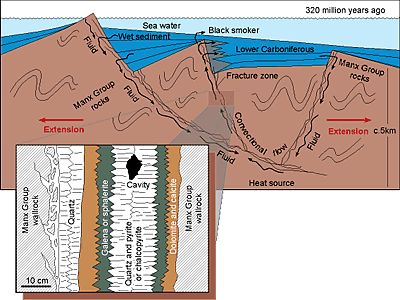The Manx ore deposits were probably formed during the Carboniferous period, around 320 million years ago, soon after the Castletown Limestone was deposited. At this time, the Earth’s crust around Northwest Europe was being pulled apart by tectonic forces similar to those responsible for the East Africa rift valley. This process resulted in deep fractures or faults down which surface water flowed to depths in the crust where the rocks were at temperatures of 100-200°C.

As the water became heated, a circulation system developed and elements, such as lead, zinc, copper, iron and sulphur were dissolved out of the deeper rocks and re-deposited within fissures at shallower levels as the fluids cooled. These crystal-lined fissures (veins) have been mined on the Island since at least the 17th century and probably as early as the Bronze Age. Galena (lead) and sphalerite (zinc) were the most common ores extracted, such as at Laxey and Foxdale, although chalcopyrite (copper ore) was the main metal extracted at Bradda Head and iron ore (hæmatite or iron oxide) at Maughold. The majority of mining had ceased by the end of the 19th century but Laxey Mine stayed open until 1919.
For more information visit www.manxmines.com